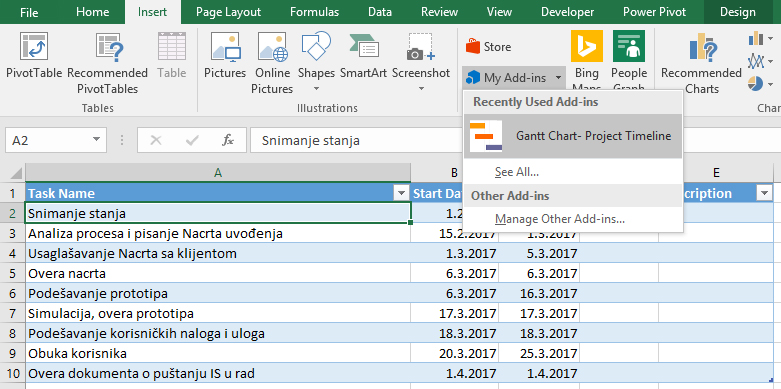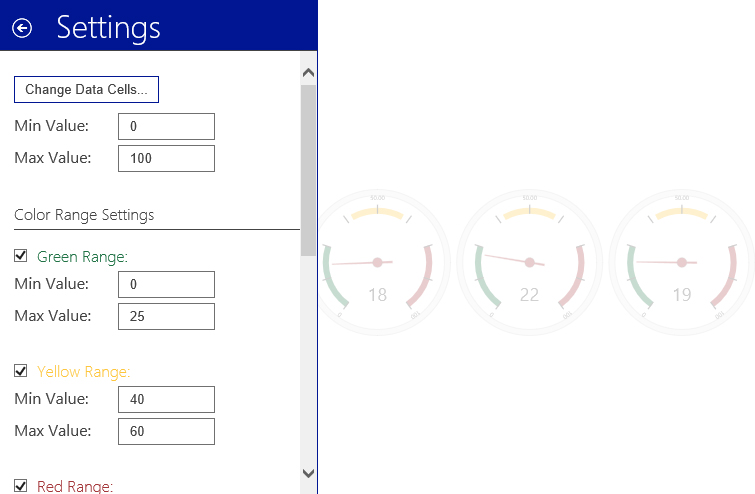Excel add-ins
Office Store is a repository from which you can download a number of add-ins, arranged by categories, developed by the rich programming community, which gives you the ability to improve the reporting capabilities of Excel. Additions differ from traditional charts because they often have an interactivity element. Look at them as small apps that serve to improve the look of your reports.
Office Store is accessed from the Insert ribbon by clicking the Store button. After this action, the window with the same name will open. On the left side there is a list of categories, and on the right the list of found add-ins. We look for them by selecting one of the categories, scrolling through the list, or, if we know part of its name we enter it in the Search box, and then search for a repository. Most add-ins are free and some are paid, which is indicated next to their names. By clicking the Add button, to the right of the name, we will download the selected add-in into Excel.

Since they are developed by numerous programming communities, the add-ins are intended to replace the missing functionalities. Part of them will eventually become part of Excel or PowerBI reporting tools. In the following text you’ll be able to see some of them…
A network diagram is an add-in that is used to show the relationships that exist between members of a network. There are several similar add-ons that can be used to draw network diagrams, and here we will show how to use GIGRAPH. After we have imported it into Excel, we need to fill in the data table. In this example, where we monitor the turnover of a bakery that sells a small number of items, the table lists articles, related items, and sold quantities by which we monitor related sales. For example. if someone bought a white bread, how many times did he buy a black bread with him. The procedure should be repeated for all items sold by the bakery. In the example, there is a table of data that we filled in randomly, and in practice we should write SQL query that would collect the total bundle from the transaction table. GIGRAPH is opened from the My Add-Ins menu, and then the columns from which the data is downloaded are listed in it.

You’ll be getting desired chart “in two shakes of a lion’s tail”. Items and links are shown in a constellation that resembles a star. The size of the mark tells you about the sales made, and each of the arrows that go from one item to the other shows the number of transactions. What can we conclude on the basis of the data on the articles and links in our case? The best-selling product is yogurt, followed by two types of bread. The smallest sold items are croissants. Bond purchase is greatest when buying white bread, when buyers buy yoghurt most. Buyers who consume white bread often buy croissants then those who buy an integral bread, etc.
The Gantt chart is a type of bar Chart used to show the project activity schedule. At x axis, the timeline is displayed, on y axis the activity names are displayed, and the bars are used to view activities within the project. The start and end of the bar indicate the start and end times, and the length displays its duration. We can make a Gant chart by modifying the Bar Chart, which was one of the earlier texts, and we can also use the add-in called Gantt Chart.
After adding it to Excel, you need to fill in a data table containing the following columns:
- Task Name
- Start Date
- End Date
- Duration
- Description
We need to fill out the table with information on project activities. In this case, we listed the typical activities that appear in the process of implementing the information system. Only the name, starting and ending date is filled in. Eventually, a description of the activity can be added. Finally, we need to transform this data into a structured table.

After selecting the Gantt Chart from the My Add-ins menu and specifying from which column the data are being retrieved, we will get an interactive chart that shows the activities within a project.

Speedometer is a simple add-in that enables us to use, with the help of graphic gauges, the key business indicators. It does not exist as a traditional Excel chart. We could do it manually, which you can read on this link, and we can also download an add-on called Gauge.
This is an add-in that is very easy to use. With it we can make one or more speedometers, and the data source for each of them is one field in the table. After we specify the range of data from which we fill the counters, we activate the add-in and display the speedometers.

If you are satisfied with the results obtained- great! If not, there is the ability to adjust the speedometer display. We do this by clicking on the icon in the upper left corner of the object, after which the Setup menu will open. In the menu, we can change the minimum and maximum values of the dials, the range of green, yellow and red zone, the display of the caption, and we can select different themes for display.

In this text, we just started to talk about the Excel add-ins. It remains for you to search the Office Store and see if some of the offerers can help you improve the appearance of your dashboards.
